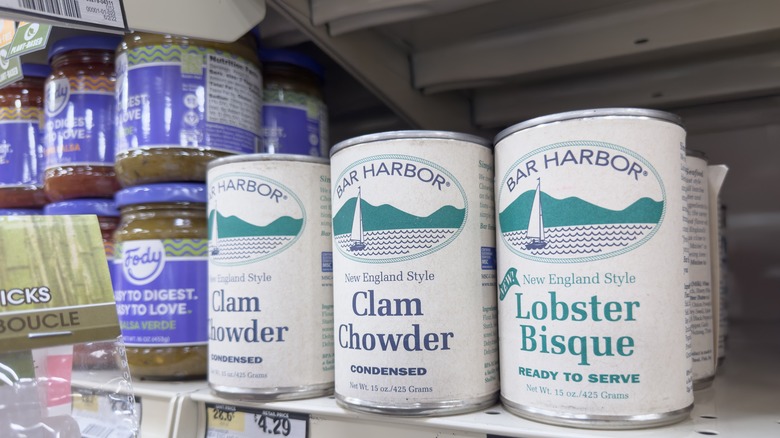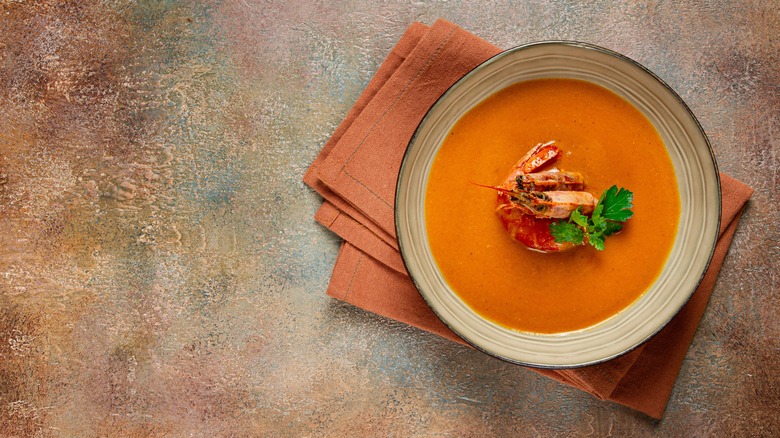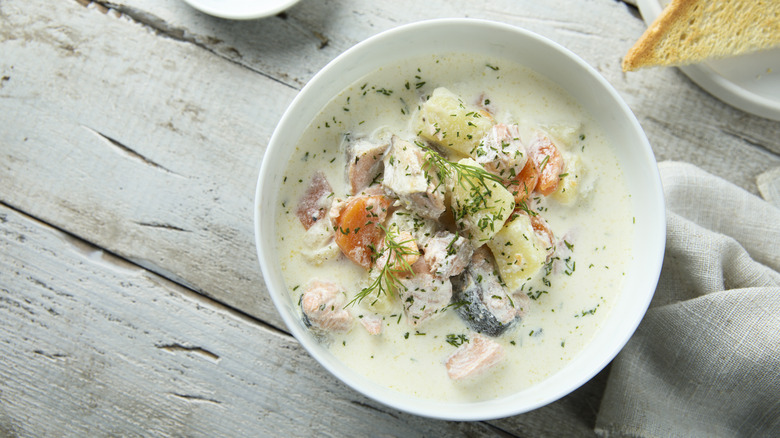The Difference Between Bisque And Chowder
Soup simply does not get enough credit for its versatility and variety. Sure, the word conjures up sick days spent in bed with crackers and ginger ale, or else it signals the changing of the seasons, a clear sign that winter is coming. But we think that soup deserves better. It deserves to be recognized in all of its varied forms, without one type being mistaken for the other. Two particularly misunderstood (and mistaken) kinds of soup are chowder and bisque, and it's easy to see why. Both soup varieties typically have a seafood base and a creamy consistency (Manhattan style clam chowder is excused from this definition and any further discussion of chowders). However, if you look beyond the creamy surface, you will see they are actually different dishes.
For starters, bisques are almost always smooth and uniform in texture, with any mix-ins being blended together or strained out. Some bisques are topped with other ingredients, such as lobster meat, but these additions go on top, after the soup is prepared. Chowder, on the other hand, is distinctly chunky. Often featuring ingredients such as potatoes and corn, having a mixture of textures and tastes is one of the defining characteristics of this soup, setting it apart from the smooth-as-silk bisque. But beyond this, these two soups also have varying origins and preparations that are important to keep in mind.
A bit about bisque
Let's start with bisque, the silky smooth soup that can be found on the menu of almost any high end restaurant. Perhaps the most well-known bisque is the lobster variety, though other varieties of fish, especially shellfish like shrimp, can also be used to make the dish. Bisques often use a seafood as the base, which is then pureed and strained. Many recipes also call for lobster shells to be cooked in the broth, making a great recipe to use an oft wasted part of your pricy lobster. Bisques also typically incorporate a roux and cream to help make the soup incredibly thick and rich.
The cooking process for bisques is also much more involved than for chowders, which often come together rather quickly. A bisque requires many cooking steps, including straining, cooking down shells, and blending your ingredients so that your soup is thick, flavorful, and totally uniform. And though there are no chunks in a typical bisque, a bowl of the rich soup is often topped with a bit of cream, olive oil, or a sprinkle of green onions, creating a simple but visually stunning presentation. Bisques are also viewed as a more high end food than chowder, which has a more homey, approachable reputation. This is probably due to the soup's difficult preparation process and use of expensive shellfish such as lobster or crab.
The chow on chowder
Now let's get to the meat and potatoes of it all. Or rather, let's get to the clam (not to be confused with mussels) and potatoes of it all. Like bisque, chowder is a rich and creamy seafood-based soup. However, unlike bisque, chowder is much easier to make, has a chunky texture, and is often less expensive. Chowder is thicker than most soups and is more akin to a hearty stew. And like many delicious stews, chowders are really quit simple to make.
Chowders can be made with or without a roux, depending on your preference, and have a base that includes both broth and cream or milk. It is cooked with a number of mix-ins, including potatoes, corn, and vegetables that help to give this soup a chunky texture. You also won't need a blender, strainer, or other specialty kitchen tools to make chowder. It's a great entry point your those wanting to dip their toes into the waters of seafood based soups. However, we think that there is room enough on the table for both chowder and bisque. It's just a matter of finding a soup that fits your mood.


